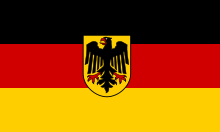Federal Post Flag

The Federal Post flag was on 7 June 1950 to 31 December 1994, an independent federal service flag , their use exclusively the Federal Post Office and the parent Ministry was allowed.
The federal post flag was abolished as a result of the transformation from a federal authority into three independent stock corporations ( Deutsche Post AG , Deutsche Postbank AG and Deutsche Telekom AG ) as part of the postal reform .
description
The Bundespostflagge was derived from the Reichspostflagge introduced in 1919 and had the horizontal stripes like the federal flag in black, red and gold . In the middle of the wider red horizontal stripe is a gold-colored post horn with a gold-colored cord, two gold-colored tassels and four gold-colored flashes of rays, the mouthpiece turned on the bar. The width ratio of the stripes is 4: 7: 4, the ratio of the height to the length of the flag cloth is 3: 5 (Order on German flags from June 7, 1950; Federal Law Gazette I: 205).
Pure woolen, hard worsted wool was prescribed as the flag cloth . The dyeing should be as fast as possible ( light , water and rub fastness). The post horn had to be affixed in the printing process to hoist and display flags.
Executions of the Federal Post Office flag
Hoisting and display flags
Thirteen different sizes of flags were used, always keeping the ratio three to five. In figurehead flags the lengths were not standardized, the widths correspond to the heights of hoisting flags.
Federal postal banners in front of the Rheinhessen Postal Museum
Service vehicles
There were three versions in different sizes for flags on company vehicles. The post horn was made from natural silk as embroidery .
Flag on the official car of the Federal Minister for the Post and Telecommunications ,
25 cm × 25 cm ,? ?

Mail signal flag for seagoing vessels
German naval and merchant ships led next to the merchant flag the Post Signal Flag as Stander , as long as they had mail on board. The postal signal flag could also be hoisted when a postal vehicle was on a ferry. The mail signal flag for seagoing vessels was intended to achieve preferential handling of the ships transporting mail. The mail signal flag for seagoing ships was suspended on September 26, 1990, as less and less mail was being transported by ship and, moreover, preferential handling of container ships was no longer possible.
Mail signal flag for seagoing ships ( mail ships ) (original)
Compared to the service flag of the Deutsche Post of the GDR
The service flag of the Deutsche Post of the GDR was also derived from the Reichspost flag between 1955 and 1973. In contrast to the Federal Post Office flag, the three stripes were the same size. With the Flag Ordinance of January 3, 1973, Deutsche Post's official flags were finally abolished on April 30, 1973.
See also
literature
- Manual dictionary of the postal system , published by the Federal Ministry for the Post Office and Telecommunications , 2nd completely revised edition, Frankfurt am Main, 1953, page 271 f.
- Peter Kaupp : 500 years post horn / historical origin / sovereign function / postal symbols. Edited by Deutsche Bundespost Postdienst, Bonn, 1990 (first published in the archive for the postal and telecommunications system, 40th edition, issue 3, August 1988).
- Albert Pfriem: The Federal Post Office Flag - End of a Tradition, in Post and Telecommunications History , Ed. DGPT , Issue 2/1995, p. 27 f.
- Meyer: The German Post Flags: A Heraldic Contribution to the German Postal History from 1867 to the Present ; in: Archive for German Postal History, Hrst: Society for German Postal History ; Issue 1 from 1960; Pp. 32-39
Individual evidence
- ↑ a b 52. Order on German flags of June 7, 1950, (BGBl. P. 205), (BGBl. III 1130-3)
- ^ German Society for Post and Telecommunication History e. V .: Post and Telecommunications History , 1st year, issue 2/1995, ISSN 0947-9945 , p. 27.
- ↑ Handwortbuch des Postwesens, Ed. Federal Ministry for the Post and Telecommunications, 2nd completely revised edition, Frankfurt am Main, 1953, page 271 f.
- ↑ Ordinance amending the Fourth Implementing Ordinance for the Flag Law Act (Post Signal Flag for Sea Ships) of September 26, 1990, Federal Law Gazette 1990 Part I, page 2144
- ^ Ordinance on Flags, Banners and Service Pennants of the GDR of January 3, 1973, SDr. 751, Journal I 1973
- ^ OJ Central Administration for Post and Telecommunications in the Soviet Zone, 1947 p. 11
- ↑ Ordinance on the use of official flags and flags. From September 27, 1955. GDR
Web links
- The Bundespostflagge - the end of a tradition by Albert Pfriem
- Federal Law Gazette for the Republic of Austria : 186. Announcement: Federal postal flag and postal signal flag for seagoing ships of the Federal Republic of Germany , issued on May 10, 2006
- Historical flags: Bundespostflagge (1950–1994)
In English:
- Reichspostflagge 1867–1921 on Flags of the World
- Reichspostflagge 1921–1933 on Flags of the World
- Reichspostflagge 1921–1933 on Flags of the World
- Reichspostflagge 1921–1933 on Flags of the World
- Federal Post Office flag 1950–1994 on Flags of the World
- Federal Post Office flag 1950–1994 on Flags of the World
- Federal Post Office flag 1950–1994 on Flags of the World












